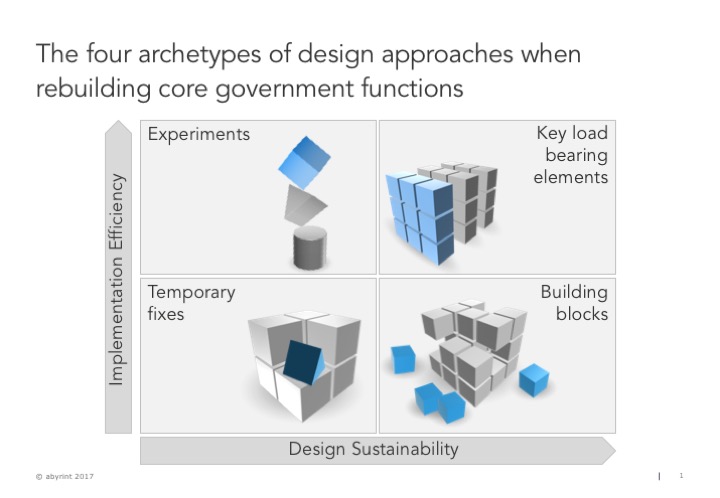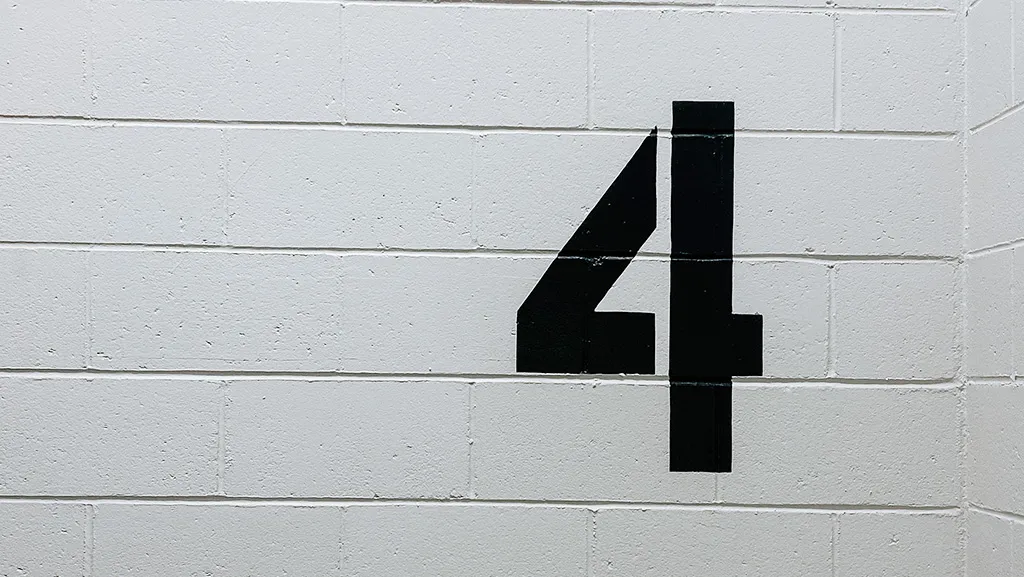Strategic Models for the Redesign of Core Government Functions
Published on: Mon Dec 11 2017 by Ivar Strand
There are four different approaches to rebuilding of government systems in fragile states. These are:
- Temporary fixes
- Experiments
- Block-by-block
- Building key load bearing elements first.
These approaches have their respective good and their bad features.
At Abyrint we are working every day to help clients rebuild government systems. Our work focuses on rebuilding the core machinery of failed states government. Without a functioning bureaucracy the political ambitions will remain lofty goals.
The approach taken to reform design is important. Be considerate from the outset of which approach to choose. A good strategic plan will select an approach to capacity building along the four pathways identified here. There are significant implications of each. It is also difficult to change path later.
We advocate an approach where the reform is distilled to its minimal features. Only focus on those few elements that are needed to deliver value. This way, the results the reform become evident quickly. This helps overcome political resistance and helps build support for further reform.
Eventually, the core government systems will need to be more advanced. This is much easier to develop incrementally when the core elements are in place.
Here is a discussion of the four alternative approaches to design and implementation of institution building. This is a different take on change management. There are also more traditional approaches to change management of large scale transformation programs.
Exhibit 1: Four types of design approaches when rebuilding core government functions

Option 1: Temporary fixes
These are solutions that from the outset are built to flip. They are not built to last. They will deliver a quick fix that may sometimes outweigh the obvious cost-benefit problem.
The problem is that such solutions will not integrate well with other government systems in the future. It is not sustainable. Be aware of the potential for temporary fixes to become permanent fixtures. Those will need much effort to change and remodel later. This additional effort may very well outweigh any benefits accrued at the early stage.
An example of temporary solutions in fragile states governments would be an international agency managing payroll lists and payment solutions for government staff. This is common in the security sector. The payments may supplement other salaries of the staff. Such solutions are often built around donor procedures and technologies. They integrate poorly with government treasury and payment systems.
For example, the Army in Somalia had several different p[ayroll systems, managed by different international agencies. They were not paying the same people consistently. And the systems were all different from the government systems.
Table 1: The good and the bad of temporary fixes
The good:
- Allows quick fixes to important problems
- Design is easier because the architects can disregard the need for integration into long term sustainable solutions
- May have low cost, in the first phase, and deliver some benefits, compared to the longer-term sustainable solution
The bad:
- Such systems are not useful building blocks for long term government systems. As such, the return on investment is limited.
- Locks in behavior in the “wrong” solutions, making it more difficult to change later
- Total cost is higher
Option 2: Experiments and pilots
This is a helpful approach when it is not clear from the outset how the final design will work. It may not be understood which solutions that are feasible to implement. The idea is to learn and adjust.
If there is true uncertainty, this may be the only viable approach. But the risk of true uncertainty can be reduced by expanding the knowledge base. The design can be more targeted from the beginning.
Experiments can also be expensive failures, or slightly better, turn out to be temporary fixes.
Finally, in politicized reform environment, there are very few windows of opportunity to change. It is rare that politics, resources and solutions align. This only appears occasionally and risking this all on an experiment may be quite a bet. Spend that political capital wisely and be more directed form the beginning if possible.
Table 2: The good and the bad of experiments and pilots
The good:
- Allows testing of solutions when there is little insight into how a complete design would work
- Less demanding on initial design solution, and can be helpful when it is not feasible to acquire more robust designs
- Yields insight into design and implementation of more sustainable solutions
- Less value at risk, as long as it is possible to adjust the solution, and that it is not fundamentally flawed
The bad:
- Unrealistic to experiment in politicized reform environment that only provides a few windows of opportunity for change
- Can be an excuse for not doing proper design and analysis of better solutions
- Total cost is potentially higher, unless you “hit” the optimal design in the first instance
Option 3: Building block approach
This is an opportunistic driven approach. These are activities that are implemented gradually. They deliver little value of their own. The system will deliver when the critical building blocks are in place.
For example: A building block would be a law that establishes an institution. This is necessary, but not enough.
Another building block may be to establish an organization. The organization on its own will not be valuable, it also needs to have systems and processes that deliver value.
A new government organization will also need to be integrated with other institutions in order to function. Those other institutions may also need to change.
For example, a financial intelligence unit is built to investigate suspicious transactions. This will only work effectively if the commercial banks are forwarding suspicious transaction reports to the unit. This may require changes in the commercial banks. It may also require technologies and processes to be built separately. Another building block.
Institution building programs in fragile states are often designed to deliver a variety of building blocks. Some building blocks may be critical, openers less so. Sometimes the reform design simply follows the blueprint of what other states look like. They mimic the function of a state rather than actually aiming to perform like one.
This can help advance system developments incrementally. One piece at a time. Nudging along. Acting on opportunities to get small blocks into place. They can be pieced together later at an opportune moment. This is the Tetris approach.
The difficulty is that the design of the building blocks needs to be consistent with the larger solutions, otherwise you will find yourself with many ill-fitting blocks, of many may need to be discarded. In such cases this becomes an inefficient approach.
Table 3: The good and the bad of the building block approach
The good:
- Seizes opportunities to get small elements in place
- Nudges development along
- Can act quickly to mobilize a full solution, when the window of opportunity appears
The bad:
- Very demanding on design, as all the pieces need to fit together, with a future solution for which designs doesn’t exist yet
- High risk of redundancy, many “tetris” pieces will need to be discarded as they don’t fit with final solution
Option 4: Load bearing elements first
This is the most efficient and sustainable approach, but also the most difficult to pull off. In these cases, you aim to deliver the core load bearing elements of the reform first, and then start delivering value, while building the rest.
This is preferred. Because valuable outcomes are delivered very early. This reduces the opportunity cost. Remember, the most expensive cost is waiting to reform in the first place. This is also more efficient. Because there is no need to rebuild or disregard other reform building blocks later.
The problem is that this is most demanding on the design. Doing this correctly requires much more of the designers than any of the other approaches. Without real quality designs, there is a risk of implementing a temporary fix or an experiment. And doing that at scale and at high cost.
But, if the designs are right, and the implementation is of quality, this is the most directed and efficient approach.
Table 4: The good and the bad of building the load bearing elements first
The good:
- Deliver value quickly
- Gets the core reform elements in place quickly and ensuring opportunity costs are not lost
- Provides time to fine-tune and adjust, at lower total cost
The bad:
- Requires very robust initial designs. This must identify the load bearing elements and the implementation pathway
Reform designers should, if possible, focus on approaches that build the load bearing elements first. This can possibly be combined with scaled-in approaches, which gives opportunity to adjust, and in that sense, brings some of the benefits from experimentation.
Temporary fixes should be avoided. Temporary becomes permanent. Institutions are built to preserve what was originally a temporary fix. People have incentives to maintain them and to resist changing them. People, systems and financing has its own momentum. This is very difficult to change later.
Better to get the design right from the beginning.
About Abyrint:
We are a management consulting firm that works to rebuild fragile states governments. We focus on core government systems. Those are systems that enable governments to: raise tax revenue, manage public finances, manage security, manage people and human resources, and create an enabling environment for private sector growth.
Ivar Strand and Ian Hawley @abyrint



